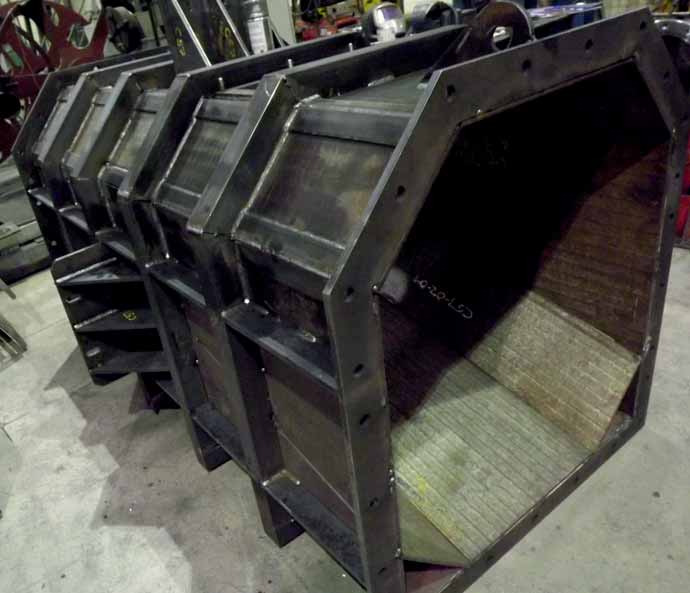
Yearly inspection project for UK’s largest bulk terminal
Inefficiency relates to the handling of abrasive and non-flowing bulk material which causes premature wear to expensive capital plant and equipment.
As material is processed through a number of transportation points being handled, stored and conveyed, a good example of a typical issue is prevalent in a UK integrated steel works. Here, operators handle Norwegian iron ore, which is renowned for its high moisture content and — as the material is conveyed through equipment such as transfer chutes, hoppers and stacker reclaimers — it tends to build up, resulting in blockages within equipment, thus restricting material from flowing through the process.
Apart from physical properties of materials, other factors also contribute to the on-going problem, such as weather conditions and portside contamination. As product is transported through different forms and modes of transport, it is left exposed to factors beyond operators’ and handlers’ control resulting in the need to factor in mechanical aids to assist product flow and the requirement to remove contaminated products.
To protect against such issues, bulk handlers implement specific design measures from the initial build of the plant or equipment along with implementing repair and maintenance regimes during annual plant shut downs.
Kingfisher was recently awarded a contract to provide annual refurbishment to the UK’s largest bulk handling ports. The inspection comprises thorough site inspection and examination of equipment used within different points of the plant, including transfer chutes, hoppers, chain conveyors and storage silos.
One such example of note is associated with the Humber International Terminal 2 (HIT2) which was commissioned in 2006. Kingfisher has been active on this site since 2007. It has provided both on-site activities and in-house-built equipment encompassing combinations of its range of ceramic, metallic and polymer lining systems that protect against the abrasive effect of the product handled, and assist with the flow and discharge of product through transfer and storage equipment.
HIT2 was commissioned in 2006. Kingfisher began to re-line chutes and various transfer points in 2007, by replacing the existing lining system with its own specification as the original lining system started to fail after nine months, whereas lining systems installed by Kingfisher provide a minimum of ten years’ life.
The vast majority of transfer points within the plant are now protected with Kingfisher’s superior 92P K-ALOX alumina ceramic wear-resistant lining system. The customer can now see the benefit of utilizing specialized companies with a proven ability to implement positive change, guaranteeing the plant’s long-term objectiveof‘troublefreeoperation’. Therelationshiphas evolved over many years and, after a recent inspection carried
out by Kingfisher, project manager Mark Bond commented, “throughout the years, Kingfisher has carried out equipment replacement and maintenance for our client as and when inspections have deemed necessary and as we have now been awarded this annual inspection we are able to provide our customer with on-going suitable and cost-effective solutions throughout the year resulting in minimal breakdown or cleaning activities which were a constant thorn in our customer’s side resulting in expensive shutdown, repair and demurrage costs.
“Due to the level of service and the quality of work completed throughout the years, the project was automatically
awarded to us based on the annual service provision we offer which eliminates some of the requirement for plant engineers to deal with ad-hoc equipment maintenance, annual inspection, report submission, outlining plant conditions, supplier price submission for the project and completion of the work when shipping and rail windows become available.
“Kingfisher is ‘beating the drum’ both in the UK and internationally, promoting the benefits of and trade-off associated with ‘repair v. replace’, as well as advising end- users and OEMs of the upside of implementing best available technologies throughout their plant and equipment. One such practice that is now becoming more prevalent is in the import, handling and storage of biomass materials used as an alternative renewable energy fuel source, in place of traditional fossil fuels such as coal and oil. Ports around the world in both developed and emerging markets are having to invest in such infrastructures to cater for materials that meet environmentally driven regulations on the need to enhance green energy production, thus reducing a nation’s carbon footprint. This relatively new bulk solid is causing the industry many concerns due to the varying characteristics of the ranges of biomass materials being utilized by power generators. Factors such as eliminating product degradation, dust control, dry conveying and storage, abrasion, flow characteristics and last but not least explosion risk are concerns that can be managed by the use of technologies and practices mention above. By working closely with industry consultants, plant designers and engineers our aim is to provide a service that can help manufacturers and end users stay ahead of the game.”